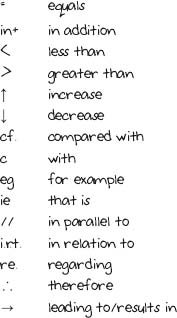5 Keeping it short: jottings, abbreviations and symbols
Once you have identified the key ideas you are in a position to take some brief notes or jottings. Indeed, you will find that highlighting on its own is a rather passive process and as a result you may not remember the ideas that you identified. Rather than returning to the highlighted text every time you want to revisit or draw upon these ideas, only to find that what you have marked does not make sense to you anymore, it is useful to develop a form of short note taking. So, getting key ideas down in shorthand form is useful both when highlighting is not enough and when you want to get working with the material more actively. Of course, some people find it useful to add short notes into the margins of highlighted texts to remind themselves of why they felt a point to be relevant or of an example they could use to illustrate a particular issue. This involves more active engagement with the text, but it is not until you start to make your own notes, in your own words (of which more in Section 8.1) that you can really check that you understand ideas enough to work with and use them, particularly in preparation for assignments and exams.
As with highlighting, you need to take care when taking short notes to be selective. Trying to get everything down is very time consuming and results in notes that are as long as the article itself! One way of both cutting down the time spent making notes and keeping them to an appropriate length is to make use of symbols, shorthand and abbreviations. You might already know some, to which you can add others that you make up throughout your time as a student. We use a whole range of symbols and abbreviations some of which are reproduced below:
In addition, we use our own form of shorthand which sometimes entails leaving out vowels or cutting off the end of words. This method is particularly effective where longer words are concerned. For example, concentrated becomes cone, advantage and disadvantage become adv. and disadv. respectively, and consequently becomes consq. Developing your own version which makes sense to you can be extremely time efficient and after a while it becomes a language of your own which flows from the pen easily.
Activity 7
Return to the Croall extract on gender and crime (Reading I) and have a go at making brief notes using any abbreviations or forms of shorthand that you know. You might want to take this opportunity to create and try out some new ones too.
You will find our feedback and comments noted in the "Now read the discussion" link beneath the article. Try not to read these until you have completed the activity.
Click below to open the extract by Hazel Croall, Crime and society in Britain.
crime and society in Britain [Tip: hold Ctrl and click a link to open it in a new tab. (Hide tip)]
Discussion
Given the individualistic nature of most shorthand there is perhaps little to be gained from us sharing our notes with you at this stage. However, you might want to take a moment to look back over the notes that you have produced and ask yourself: are they short and to the point?, can they be edited down in any way?, what might I need to add to make them even more helpful? If you do need to be even more succinct, have another go now. Similarly, if you can think of things you might usefully add – an illustrative example, or page references – to help you find key points again, add them in now.

